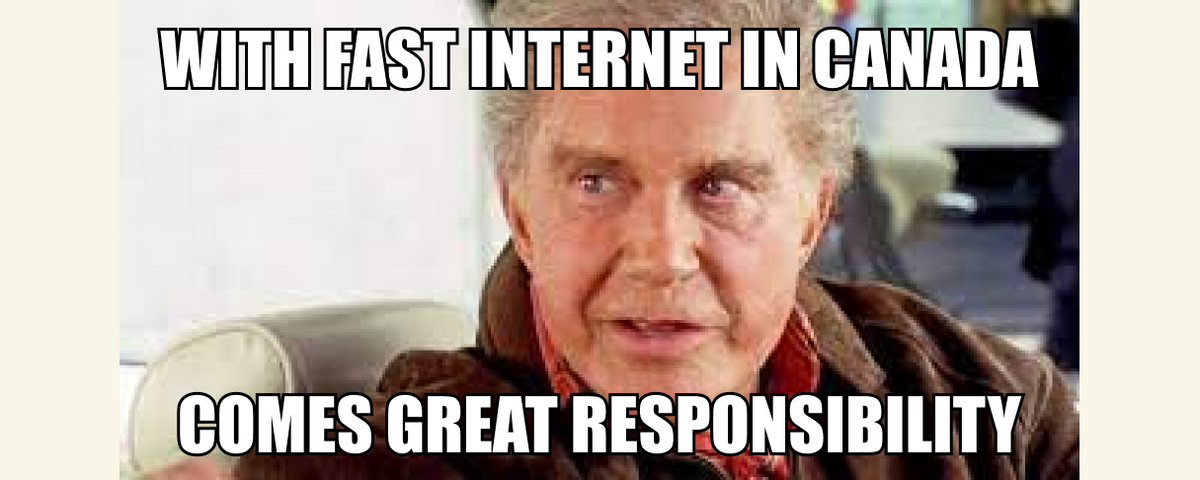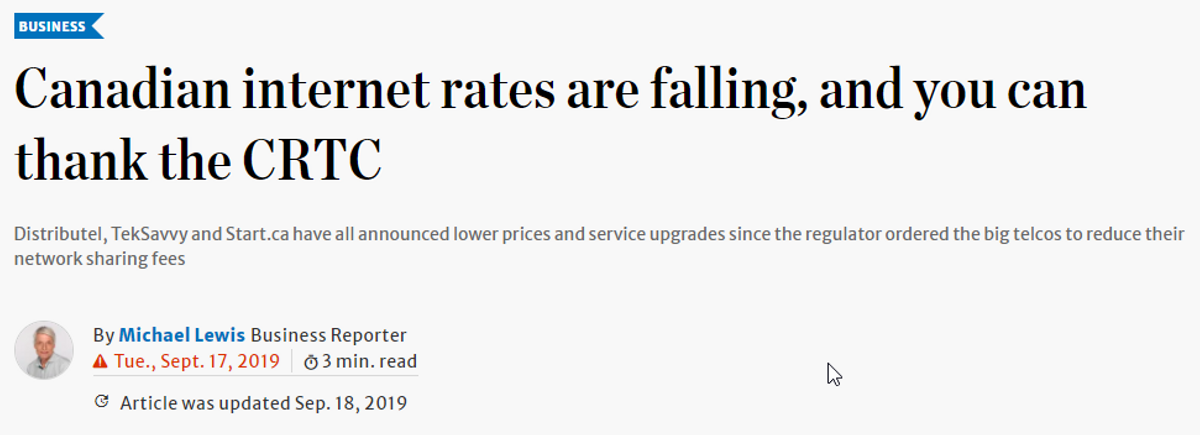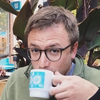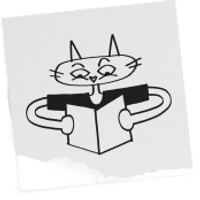Canada’s—aka our—telecommunications industry is just waiting to be made into a TV show. We’re getting Succession meets Suits vibes and we just so happen to know a couple of pretty good writers, you know, if you know someone who works in TV. Anyways… Lately the news has been talking a lot about the big three (and sometimes five) telcos: their independent ISP buying spree, the increasingly high prices they charge because of a lack of competition, the epic outages, the bad customer service. It’s all over the place. But, despite all the coverage, not much seems to be changing—it might even be getting worse. We have a feeling that part of the problem is that it’s confusing AF. Well, we’re here to help. Or at least try. So, let’s get this started with a TL:DR.
- In Canada, our network infrastructure is shared.
- To make that work, the CRTC divided internet companies into two(ish) groups: the dominant players and the independent players.
- Dominant players control the vast majority of the telecom market, including the infrastructure.
- Independent players are the small telco companies that build and maintain their own networks. They are not resellers, they are wholesale based internet service providers who build and maintain their own backend infrastructure that connects to the networks maintained by the dominant players.
- The CRTC decides what wholesale rate (tariff) the dominant players can charge.
- In 2016 the tariffs were so high that the CRTC temporarily lowered the rates1. These interim rates were up to 85.6% lower.
- On August 15, 2019, after three years of research, the CRTC announced the new tariffs that were retroactive to 2016 and up to 82% lower—and still included a 30% markup for the dominant players.2
- In 2019 the big telcos banded together to fight the new tariffs.
- In the spring of 2021, the CRTC decided to cancel everything and make the 2016 rates permanent.
- Yes. That was a random and suspicious decision.
- The good news: The Government of Canada has released a new policy direction for the CRTC that is pro-independent ISPs.
Okay, if you’re still reading, it’s either because you’re actually interested in this stuff or at least a little curious (an attractive quality) or you’re just procrastinating.

Either way, we’re glad you decided to stick around.
Before we go any further, we think it’s probably worth agreeing on a few definitions.
What’s the difference between a big telco, a TPIA, an independent internet service provider, and an internet service provider?
We thought you’d never ask!
Let’s start with internet service providers (aka ISPs).
Internet service providers (ISPs) are anyone and everyone who sells internet services. ISPs are like the tippy top of the iceberg—aka there’s a lot that goes on underneath that title. First up, when it comes to ISPs, there are two types of players: dominant and independent.
Dominant players are the big telcos.3 The ISPs that control the vast majority of the telecommunications market in Canada, including the infrastructure. To understand what’s happening today, all you need to know is that in 1998 the CRTC realized that competition would be good for the telecommunications industry and decided to force the dominant players to allow independent players to access their networks.
Fun fact (As if this whole article wasn’t full of fun facts!): Which telco is dominant and which is not is something we’d love to define for you. But we can’t. We have no idea what the criteria is. Our best guess is that they were chosen if they had market power. One of the weirder examples is TELUS. TELUS is a dominant player in Western Canada, but TELUS QC is not considered a dominant player. Weird but true.
Independent players are divided into two teams:
- The small telco companies that build and maintain their own networks. They don’t have to share access because the CRTC doesn’t define them as dominant players.
- Wholesale based internet service providers who do not own any infrastructure and pay wholesale rates defined by the TPIA to connect to and use the infrastructure maintained by the dominant players.
So, now you know the difference between an ISP, an independent ISP, the big telcos and TPIAs.
DAVID: I still don’t understand what a TPIA is.
FRANCIS: Right. Well,
A TPIA stands for:
Third Party Internet Access. It’s not a type of company (we know, this was shocking to us as well), it’s a tool within the CRTC’s wholesale regime.
DAVID: Nodding his head like he 100% understands, but isn’t convinced any of those are actual real words.
Another exciting fact: So, before we go any further, you're probably wondering what a wholesale regime is. Well, because most telecommunication industries tend to lean towards monopolies partly because of the cost of the infrastructure, governments around the world use wholesale regimes (basically a set of laws or toolkit) to force telecom companies to share their network infrastructure. TPIA is one of the tools in the wholesale regime toolkit. If wholesale regimes didn’t exist, our telecom industry would most likely—okay, pretty definitely—still be a monopoly instead of an oligopoly-ish.
So, back to TPIA. TPIA is the agreement between dominant players and wholesale based internet service providers like oxio. It outlines the tariff, rules, etc. that both players need to follow.
Okay, but all this seems to still favour the dominant players.
In Canada we decided to favour our dominant players because we believed they were the ones who would be able to invest in new infrastructure, develop new regions, and innovate. And this was kind of true for a while. But, and this is a pretty big but, now the dominant players have reached maturity. The networks are pretty much all built—and the government is funding the construction in the remaining regions4—and the big telcos are now just making way too much money5,6. We need to change the rules of the wholesale regime to better reflect the realities of the current internet landscape in Canada.
You’ve probably heard that in Europe you can get unlimited internet plans (not to mention mobile) for way, way less than in Canada.7 Up to 42% less.2 Why? Because in Europe they adapted their wholesale regime to force their dominant player to share their network infrastructure at reasonable prices. This resulted in more competition which led to lower prices. Some claim that these lower prices are because they have a less reliable network. Turns out that’s kinda bullshit. Just look at what happened recently with the epic outage in Ontario. Not to mention the stress test of COVID—we’ll chat about that a little later on.
So, now that we know what’s what, let’s get into why the heck Canada’s internet companies can’t just all get along.
Okay. We all probably need a bit of background.
Lucky for us, Francis (our Head of Telcom and co-founder) is obsessed with this stuff.
It all kind of started in 2016.
DAVID: Wait. I thought the internet started catching on in the early 90s?
FRANCIS: Well yes. But for the first 20ish years, we were all happy taking what we could get. Remember having to install the internet onto your computer using an AOL CD? The joys of dial up? We were all just happy that it all actually worked.
DAVID: Right… All the “beep-static-boop-static-static-beep…”
FRANCIS: Exactly. So, we’re just gonna skip ahead to 2016.
DAVID: Fair enough.
FRANCIS: Independent internet service providers (indie ISPs) were unhappy with the very high tariffs the big telcos charged for access to the network infrastructure. These wholesale tariffs were so high that the CRTC did something unusual: they lowered the rates almost immediately. Unusual because the wholesale tariffs are the result of a very rigorous process that usually lasts a few years.
DAVID: Hold on. What the heck are these tariffs you’re talking about?
FRANCIS: Tariffs are the fees the infrastructure providers charge independent ISPs to purchase wholesale bandwidth for resale to their customers. As an example: here at oxio we pay our infrastructure partner in Ontario $37 for every customer who subscribes to our 75 Mbit/s unlimited home internet plan. And yes, that is a very high tariff.
DAVID: Okay, a quick and shameless plug: you can see a transparent breakdown of all our internet prices here. But we’re getting ahead of ourselves.
FRANCIS: Back to 2016.
After the CRTC lowered the rates, they made a deal with everyone: “Listen, indie ISPs, we heard you. We also think the rates are too high. Let’s make them up to 85.6% lower.2 We know this is a conservative figure, but it’s just for the interim while we start a consultation process, collect the data, validate it and crunch some numbers. Once this is done, we will come up with definitive rates and ask the big guys to pay you back proactively. Is that fine with everyone?”
— Francis Careau, paraphrasing the CRTC 😆
Yes, said everyone—the indies and the big telcos. To be honest, the rates were still too high, but at least with the interim rates, indie players had a bit of breathing room. Brighter days were ahead. And anyway, indie ISPs would get retroactive payments once the CRTC had crunched the numbers and realized the interim rates were still too high.
2019 really did start off on the right foot.
After a lengthy, and very thorough consultation process, the CRTC released the final tariff rates. And they were fair. After 3 years of data gathering and analyzing, the CRTC finally had something that was financially viable for both parties: the indies and the big telcos. Rates were going to be up to 82% lower and would result in almost $325M in retroactive payments. And that resulted in the independent ISPs lowering their prices by between $15 and $20 for the unlimited, high-speed plans.2 I know, that sounds like a lot, but keep in mind that for almost 10 years, big telcos were over-charging the independent ISPs.8,9 And what’s $325M when the combined revenue of Bell, Rogers, Telus, Shaw, and Quebecor was around 46.4 billion in 2020?10
DAVID: Excuse me? Million or billion?
FRANCIS: Billion. 46.4 billion dollars shared between five companies. Or 86.9% of total revenues for 0.6% of the telecom providers in Canada. Oh, and as a nice, sweet cherry on top, the 5 big telcos have been growing in market share while the around 985 independent players have been declining by 1 or 2 percentage points per year since 2016.10,11
So, this was a (good) shock to the industry. I (Francis) remember seeing the rates and telling myself: “Yeah, we have something to work with now! That’s gonna be good for all Canadians!” My joy was short-lived: not even a couple of days after the announcement, the big telcos held hands and appealed the decision. It’s rare to see Eastlink, Videotron, Bell, Rogers, TELUS, SaskTel and Shaw work together. But when it’s to protect their profits, they definitely do! They used every single legal mechanism available to push their appeal: the justice system, the House of Commons, and the CRTC’s own appeal system.
What happened between 2019-2022.
Let the saga begin and buckle up because it’s even better than Law & Order! Spoiler alert: big telco wins, leaving us all paying more for our internet. But what actually happened? Let’s take a look at every tool they used:
The legal system.
Scared, the big telcos went to the Federal Court of Appeal to request a temporary suspension of these new tariffs. They won, but it was just temporary.12 In an attempt to make this permanent, they addressed the Supreme Court of Canada.13 And, in a little win for all us indie ISPs, the Supreme Court refused to hear the case.14
The House of Commons.
The Standing Committee on Industry, Science and Technology, which has the mandate to advise ministers on everything related to industry, science and technology—aka the internet— ruled in our favour. They even suggested that the CRTC should fix the tariffs halfway between the 2019 and 2016 rates. Sadly, they do not have any power. But they were clear: if the new tariffs stick around, wholesale-based providers are in danger.
The CRTC’s own appeal system.
This is where the story gets real crunchy. You would have thought that the CRTC was on our side, right? They used a pricing model that all the indie and big players had agreed to. They spent three (3!) years making sure the process was ridiculously accurate. They had two rounds of consultations—being as patient, fair and rigorous as possible with the big and indie players. The tariffs they landed on were qualified by all the telecom analysts and journalists as fair and in the best interest of Canadians.2



Everything was pointing towards the CRTC making a decision based on data. But then the big telcos appealed the CRTC’s own decision to the CRTC and well as ridiculous as it all sounds…15
In the spring of 2021 the CRTC decided to cancel everything and make the 2016 rates permanent.
Wow, that seems very weird and out-of-the-blue. Damn straight it is. And it gets even weirder. Back in 2017, a new chairman was appointed. This is important because the 2019 tariff decision was mostly the doing of the previous chairman Jean-Pierre Blais, a long-time public servant.16 In 2017, Ian Scott, an ex-TELUS lobbyist, became chairman.
Of course, the 2019 decision on lower, fair and reasonable tariffs was to our advantage, but that decision probably happened because it was led by another chairman. We may never know for sure, but we’ll just leave a quote from Jean-Pierre Blais right here:
Competitors that provide retail internet services to Canadians using wholesale high-speed services must have access to these services at just and reasonable prices. The fact that these large companies did not respect accepted costing principles and methodologies is very disturbing. What's even more concerning is the fact that Canadians' access to a choice of broadband internet services would have been at stake had we not revised these rates. As always, we strive to create a dynamic competitive telecommunications market for Canadians.17
- Jean-Pierre Blais, CRTC Chairman and CEO
… and say that just a couple of days after the new tariffs were released, Ian Scott was seen having an off-the-record chat with Mirko Bibic (CEO of Bell) at an Ottawa pub.18 From there, everything went downhill and the CRTC issued decision after decision after decision in favour of the big telcos. Well, that’s what we think anyways.
The present. Aka right back where we started, kinda.
This 7-year saga came to an end on May 26th, 2022. A petition was sent on July 15, 2021 asking the government to intervene and revert back to the 2019 tariff rates. Attached to this petition was a 77-page document describing how harmful the CRTC has been to wholesale-based providers.19
Innovation, Science, and Economic Development Canada (ISED) did not ask the CRTC to revert the rates. Instead they issued a Policy Direction.20
DAVID: Ah. Wait. ISED? Policy direction?
FRANCIS: I’m getting there.
They justified this decision by saying that reversing the rates would create instability in the industry. Of course, oxio and pretty much all the indie internet service providers were disappointed by the refusal of ISED to honour the tariffs the research had proven were fair.21 But, being sad and complaining isn’t productive. We need to look forward, and the new Policy Direction is something we can all be very happy about. Or at least understand that it’s the best the government could give us.
So what’s a Policy Direction?
First, it’s important to understand that the CRTC is a commission, meaning that it’s independent of the government and is not led by an elected official. The CRTC’s mandate is to administer the Telecommunications and Broadcasting Acts.22 All that means is that the CRTC is in charge of regulating the telecom, TV and radio industries in Canada. ISED is the ministry in charge of the CRTC and it’s led by an elected official. As of 2022, Francois-Philippe Champagne is the minister responsible for ISED. Since no one can interfere with how the CRTC operates, the ISED has 3 tools to perform their duties:
- The Telecommunications Act: defines how to regulate internet, TV, and phone services;
- The Broadcasting Act: defines how to regulate TV and radio channels;
- Policy directions: instructs the CRTC on how they should interpret both acts and sets goals for them to achieve.
No one can interfere with the CRTC or change the Telecommunications or Broadcasting Acts willy-nilly. Short of changing the Broadcasting Act (which takes a while because we live in a democracy), the only way to direct the CRTC is to issue a policy direction. And, on July 20, 2022, that is exactly what happened.23
ISED issued a new policy direction.
Here’s why this is important: before the new policy direction there were two active policy directives. There was the 2006 policy, that was pro-big telcos, and the 2019 one that was pro-indie ISPs.24 This gave the CRTC the power to swing their policies all over the place. The new policy scraps the 2006 (pro-big telco) and 2019 (pro-indie ISP) for a new one that’s very pro-indie ISP. And, this is good news for Canadians!
And they all lived happily ever after.
DAVID: Really!? That’s it?
FRANCIS: LOL. Probably not. But it’s too soon to tell.
Okay, that was a great story. But can you just tell us why the internet in Canada is so expensive?
Canada has frequently ranked among the priciest countries in the world for internet—this study puts us 166th and this one has us hovering between the most and third most expensive out of the G8 countries. And the reason isn’t just because of our unique relationship between geography and population. Other countries with similar attributes, like Australia, manage to have better prices.
Some argue that Canada’s prices are because of our state-of-the-art telecommunication system. This is partly true. Our broadband and wireless networks are technologically very advanced and very robust. But we recently had an epic test on our network: COVID-19. Lockdowns put immense pressure on every country’s telecommunication system. Did Canada perform better than other G8 countries? No. We did just as well. Not better.25
So all that means:
Good prices + resilient networks are not a coincidence. They’re the result of good regulatory policies.
So what the hell is the CRTC doing, then?
You might have felt an undertone of corruption when Ian Scott met with Mirko Bibic. We sure did. But, it was apparently just a feeling.26 One thing’s for sure though: the big telcos have an almost infinite lobbying budget to sway government policy and the CRTC. But is this really the reason behind Canada’s higher prices?
No. It definitely has an impact, but it’s not the main reason.
The main reason internet in Canada costs so damn much is because it’s based on facilities-based policies.
DAVID: Okay. Wow. I think I need to look up a few things. So, let’s take a minute.
First, what are “facilities-based policies”? Well to understand that, we need to define facilities-based providers (FBP).
So, what’s a facilities-based provider? Well…
A facilities-based provider (FBP) is a service provider who builds, owns and operates a physical telecom network that provides telecom services to users either by the FBP or another service provider.27 So, in Canada, that would be what we lovingly call the big telcos.
And that means facilities-based policy is…
Policy that favours the facilities-based providers—aka the big telcos.
DAVID: Well now that we know what the heck all that means, it’s really not surprising. But…
FRANCIS: But what’s the alternative?
DAVID: But what’s the alternative?
Spoiler: public investment.
The Government of Canada and the CRTC want to see new telecom infrastructure built. That’s fair and important. A nation’s telecommunications system depends on the strength of its infrastructure. You know, having actual 5G towers, telephone poles, fibre-optic lines and a workforce to maintain it. However, at oxio, we believe that the CRTC is approaching this all wrong. Pushing for policies that are in favour of network owners, at the expense of wholesale-based providers, doesn’t have a proven record of encouraging new network infrastructure builds.28
Public investment does.
Programs like the Universal Broadband Fund have successfully funded $2.75 billion in new infrastructure. And that’s just the tip of the iceberg.29 The government of Canada and the government of Ontario have committed a total of $11.2 billion to expand and improve Canada’s broadband infrastructure.30 That works out to be around 90% of the total construction costs for new network infrastructure.
We think the CRTC, through excellent lobbying by the big telcos, creates the narrative that facilities-based policies encourage rural infrastructure deployment. But, the data just doesn’t back this up. What does work are:
- Wholesale-based policies (aka supporting indie players) stimulate competition and lower retail prices.
- Public infrastructure funds help network owners to close the connectivity gap experienced by remote locations.
We all pay for infrastructure deployments because it’s rare for big players to invest in remote communities from their own pocket. Pushing for facilities-based policies when the government is literally paying for the infrastructure of the big telcos is not fair.
Throwing a tantrum—even if we REALLY want to—won’t help. Educating Canadians will.
We hope that the pro-big telco reign is now over. But we’re not convinced. Sure, the Government recognized their mistakes by instructing the CRTC to care more about indie ISPs (via the new Policy Direction) and we are getting a new CRTC chairperson that will replace the very pro-big telco chairman Ian Scott. But that still leaves a lot of unknowns: who will be the new chairperson of the CRTC? How will they interpret the Policy Direction? Will it matter or have the big telcos gotten away with too much for too long? We don’t know. But we do know that we’re not going anywhere. We’re here to answer your questions as best we can. To do our best to help Canadians learn about Canada’s internet. And to share our ideas for how we think it should all work.
Massive (like enormous) thanks to Francis Careau for all his knowledge and just straight-up writing the first draft. And to Bryson Masse from CNOC for double--and triple--checking all our data. Oh and of course, to Danilo for adapting in French, but you're used to that by now.
- CRTC finds proposed wholesale high-speed access rates unreasonable
- Notice No. TIPB-002-2019 Petitions to the Governor in Council concerning Telecom Order CRTC 2019-288
- Telecom Decision CRTC 94-19
- Tab C: Briefing Notes - ISED
- Rogers profits jumped 35% in the three months prior to the recent outage | CBC News
- Telus' net income soars 45% in Q2 as it reports rise in mobile, internet customers
- Canadians want more competition in the telecom sector, survey shows
- Telecom Order CRTC 2019-288
- FOLLOW-UP TO TELECOM ORERS 2016-396 AND 2016-448
- Communications Market Reports - Annual highlights of the telecommunications sector 2020 | CRTC
- application.crtc.gc.ca
- Big telecom companies win court battle in ongoing war with CRTC over wholesale internet rates | CBC News
- Canada's big cable companies ask court to overrule CRTC's wholesale rates | CBC News
- Court rejects Bell, Rogers appeals of CRTC decision on wholesale internet rates | CBC News
- Petition to the Governor in Council to Vary Telecom Order CRTC 2019-288, Follow-up to Telecom Orders 2016-396 and 2016
- CRTC scolds big telecoms for 'not just and reasonable' wholesale rates | Financial Post
- CRTC finds proposed wholesale high-speed access rates unreasonable
- CRTC chairman Ian Scott defends meeting with Bell CEO at pub | National Post
- PETITION BY COMPETITIVE NETWORK OPERATORS OF CANADA TO THE GOVERNOR IN COUNCIL TO RESCIND TELECOM DECISION CRTC 2021-181, REQUE
- Ottawa rejects internet rates appeal, sets new CRTC policy to boost telecom competition
- CNOC Disappointed by CRTC Decision That Supports the Status Quo
- Our Mandate, Mission and What We Do | CRTC
- Proposed policy direction to the CRTC for competition, affordability, consumer rights and universal access
- Major cable companies launch appeal of CRTC ruling on wholesale internet rates - The Globe and Mail
- Renewing Canada’s approach to Telecommunications Policy: Context for Action
- Ethics watchdog clears CRTC head Ian Scott over 2019 meeting at bar with incoming Bell CEO
- Facilities-based provider Definition | Law Insider
- Affordability and Accessibility of Telecommunications Services in Canada: Encouraging Competition to (finally) Bridge the Digital Divide
- High-speed Internet for all of Canada
- Governments of Canada and Ontario invest up to over $170 million to bring high-speed Internet to Northeastern Ontario








